Social media marketing: Strategy template and tips for 2025
A social media marketing strategy is a summary of everything you plan to do and hope to achieve on social media. It guides your actions and lets you know whether you’re succeeding or failing.
The more specific your plan is, the more effective it will be. Keep it concise. Don’t make it so lofty and broad that it’s unattainable or impossible to measure.
In this post, we’ll walk you through a nine-step plan to create a winning strategy for social media marketing. We’ve even got expert insights from Amanda Wood, Hootsuite’s Senior Manager of Social Marketing.
tl;dr? If you’re looking for social media marketing help, you’re in the right place.
Key takeaways
- A social media marketing strategy outlines your goals, the tactics to achieve them, and the metrics you’ll use to track success. It serves as a roadmap for all your social media efforts and aligns them with your broader business objectives.
- Unlike traditional marketing and advertising, social media marketing fosters two-way communication between brands and their audiences. It’s about engaging with customers on a personal level, building trust, and cultivating a sense of community to nurture long-term loyalty — not just driving immediate sales.
- Social media is always changing! Social media strategies should be dynamic and adapt to new trends and audience behaviors.
What is social media marketing?
Social media marketing is the practice of using social media platforms and tools to promote your business and connect with your audience.
Businesses use it to:
- showcase their products or services
- (perhaps more importantly) engage with their customers on a personal level
The intended outcomes can range from the somewhat abstract (like brand building) to the very specific (like selling products through social commerce). Driving web traffic, increasing sales, and nurturing customer loyalty are all common goals of social media marketing.
Social media marketingia marketing is about building relationships with your audience in the places they already spend their time online. This might look like promoting your latest product drop, or simply jumping in on a trend that your audience is interested in.
Unlike traditional advertising, like TV spots and billboards, social media marketing allows for two-way communication between individuals and brands. There’s also potential for building a sense of community, which creates brand loyalty.
This, plus the ability to accurately track, analyze, and optimize on your results, is what makes social media marketing a truly unique marketing space.
What is a social media marketing strategy?
A social media strategy is a document outlining your social media goals, the tactics you will use to achieve them and the metrics you will track to measure your progress.
Your social media marketing strategy should also list all of your existing and planned social media accounts along with goals specific to each platform you’re active on. These goals should align with your business’s larger digital marketing strategy.
Finally, a good social media plan should define the roles and responsibilities within your team and outline your reporting cadence.
Creating your own marketing strategy for social media (video guide)
No time to read the whole article? Let Amanda, Hootsuite’s own Senior Manager of Social Media Marketing, guide you through our free strategy template in less than 10 minutes:
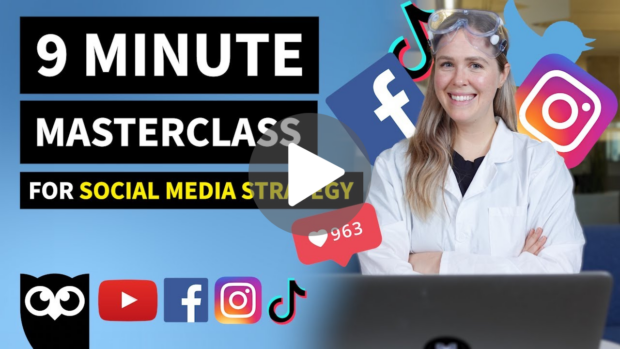
How to create a social media marketing strategy: A step-by-step guide
Step 1. Align goals with business objectives
Set S.M.A.R.T. goals
The first step to creating a winning social media strategy is to establish clear objectives and goals. Without goals, you have no way to measure success and return on investment (ROI).
Each of your social media marketing goals should be SMART: specific, measurable, attainable, relevant and time-bound.
Psst: Need help getting started? We’ve got social strategy guides for small businesses, financial services, government, higher education, healthcare, real estate, law firms, and non-profits.
Oh, and if you need examples of smart social media goals, we’ve got you covered there too.
Once you’ve decided on your social goals, track them in a strategy doc — grab our free social media strategy template if you don’t have one already.
Track meaningful metrics
Vanity metrics like number of followers and likes are easy to track, but it’s hard to prove their real value. Instead, focus on things like engagement, click-through, and conversion rates.
Not sure where to start? If you need inspiration, take a look at these essential social media metrics.
You may want to track different goals for different social media networks, or even different uses for each network.
For example, if you use LinkedIn to drive traffic to your website, you would measure click-throughs. If Instagram is for increasing brand awareness, you might track the number of Instagram Story views. And if you advertise products or services on Facebook, cost-per-click (CPC) is a common success metric.
Social media goals should align with your overall marketing objectives. This makes it easier to show the value of your work and secure buy-in from your boss.
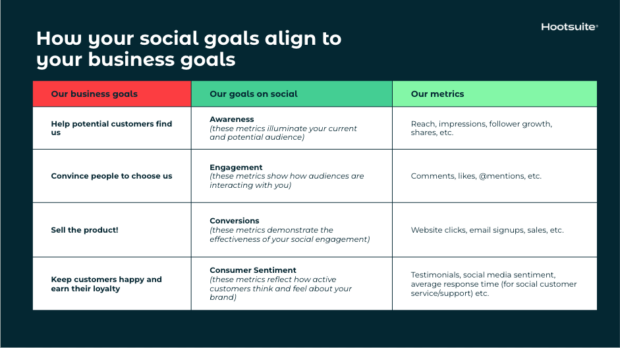
Start developing a successful social media marketing plan by writing down at least three goals for social media.
“It’s easy to get overwhelmed by deciding what to post and which metrics to track, but you need to focus on what you want to get out of social media to begin with,” says Amanda Wood, Hootsuite’s Senior Manager of Social Marketing. “Don’t just start posting and tracking everything: match your goals to your business, and your metrics to your goals.”
Step 2. Understand your audience inside and out
Get to know your fans, followers, and potential customers as real people with real wants and needs, and you will know how to target and engage them on social media.
When it comes to your ideal customer, you should know things like:
- Age
- Location
- Average income
- Typical job title or industry
- Interests
- etc.
Here’s a simple guide and template for creating audience/buyer personas.
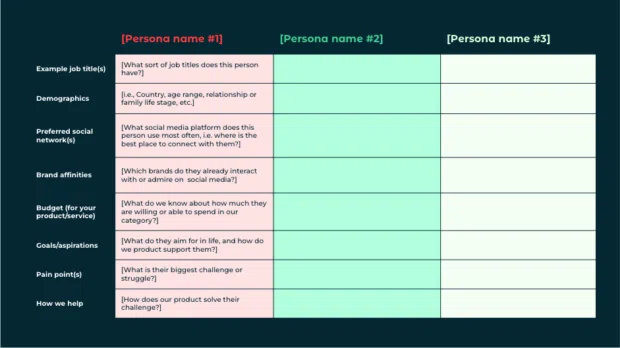
Don’t forget to document this information in your strategy doc!
Social media analytics can also provide a ton of valuable information about who your followers are, where they live, and how they interact with your brand on social media. These insights allow you to refine your strategy and better target your audience.
Jugnoo, an Uber-like service for auto-rickshaws in India, used Facebook Analytics to learn that 90% of their users who referred other customers were between 18- and 34-years-old, and 65% of that group was using Android. They used that information to target their ads, resulting in a 40% lower cost per referral.
Check out our guide to using social media analytics and the tools you need to track them.
Step 3. Analyze your competitors’ strengths and weaknesses
Odds are your competitors are already using social media, and that means you can learn from what they’re doing.
Conduct a competitive analysis
A competitive analysis allows you to understand who the competition is and what they’re doing well (and not so well). You’ll get a good sense of what’s expected in your industry, which will help you set social media targets of your own.
It will also help you spot opportunities and weaknesses you can document in your social strategy doc.
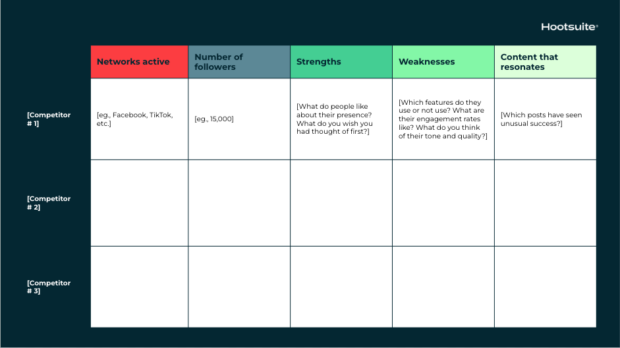
Maybe one of your competitors is dominant on Facebook, for example, but has put little effort into X (Twitter) or Instagram. You might want to focus on the social media platforms where your audience is underserved, rather than trying to win fans away from a dominant player.
Use social media listening
Social listening is another way to keep an eye on your competitors.
Do searches of the competition’s company name, account handles, and other relevant keywords on social media. Find out what they’re sharing and what other people are saying about them. If they’re using influencer marketing, how much engagement do those campaigns earn them?
Pro tip: Use Hootsuite Listening to monitor relevant keywords, hashtags and accounts in real-time.

As you track, you may notice shifts in how your competitors and industry leaders are using social media. You may come across new, exciting trends. You might even spot specific social content or a campaign that really hits the mark—or totally bombs.
Use this kind of intel to optimize and inform your own social media marketing strategy.
Just don’t go overboard on the spy tactics, Amanda advises. “Make sure you aren’t ALWAYS comparing yourself to the competition — it can be a distraction. I’d say checking in on a monthly basis is healthy. Otherwise, focus on your own strategy and results.”
Step 4. Conduct a social media audit
If you’re already using social media, take stock of your efforts so far. Ask yourself the following questions:
- What’s working, and what’s not?
- Who is engaging with you?
- What are your most valuable partnerships?
- Which networks does your target audience use?
- How does your social media presence compare to the competition?
Once you collect that information, you’ll be ready to start thinking about ways to improve.
We’ve created an easy-to-follow social media audit guide and template to walk you through each step of this process.
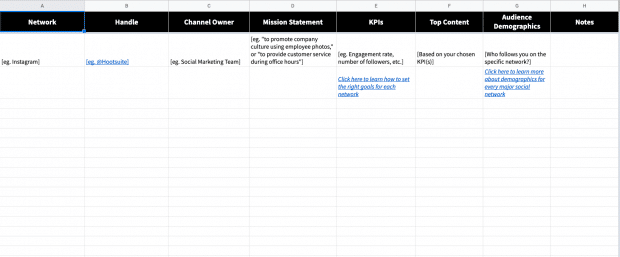
Your audit should give you a clear picture of what purpose each of your social accounts serves. If the purpose of an account isn’t clear, think about whether it’s worth keeping.
To help you decide, ask yourself the following questions:
- Is my audience here?
- If so, how are they using this platform?
- Can I use this account to help achieve my goals?
Asking these tough questions will keep your social media strategy focused.
Look for impostor accounts
During the audit, you may discover fake accounts using your business name or the names of your products.
These imposters can be harmful to your brand—never mind that they’re capturing followers that should be yours.
You may want to get your accounts verified too to ensure your fans know they are dealing with the real you.
Here’s how to get verified on:
Step 5. Set up and optimize your accounts
Decide which networks to use
As you decide which social networks to use, you will also need to define your strategy for each.
Hootsuite’s own social team designates different purposes for formats within networks. On Instagram, for example, they use the feed to post high-quality educational infographics and product announcements, while Stories is used to cover live events or quick social media updates.

Pro tip: Write out a mission statement for each network. A one-sentence declaration to keep you focused on a specific goal.
Example: “We will use X for customer support to keep email and call volumes down.”
Or: “We will use LinkedIn for promoting and sharing our company culture to help with recruitment and employee advocacy.”
One more: “We will use Instagram to highlight new products and repost quality content from influencers.”
If you can’t create a solid mission statement for a particular social media channel, you may want to ask yourself if it’s worth it.
Note: While larger businesses can and do tackle every platform, small businesses may not be able to — and that’s ok! Prioritize social platforms that will have the most impact on your business and make sure your marketing team has the resources to handle content for those networks. If you need help focusing your efforts, check out our 18-minute social media plan.
Set up your profiles
Once you’ve decided which networks to focus on, it’s time to create your profiles. Or improve existing ones so they align with your strategy.
- Make sure you fill out all profile fields
- Include keywords people would use to search for your business
- Use consistent branding (logos, images, etc.) across networks so your profiles are easily recognizable
Pro tip: Use high-quality images that follow the recommended dimensions for each network. Check out our always-up-to-date social media image size cheat sheet for quick reference.
We’ve also got step-by-step guides for each network to walk you through the process:
- Create a Facebook business page
- Create an Instagram business account
- Create a TikTok account
- Create a X (Twitter) business account
- Create a Snapchat account
- Create a LinkedIn Company Page
- Create a Pinterest business account
- Create a YouTube channel
Don’t let this list overwhelm you. Remember, it’s better to use fewer channels well than to stretch yourself thin trying to maintain a presence on every network.
Optimize your profiles (and content) for search
Never heard of social SEO? It’s time to learn.
44% of Gen Z consumers use social platforms to research their purchase decisions, which means it’s extra critical that your channels are optimized for social search.
That means making sure your profile names are clear and descriptive, you’re including relevant hashtags and keywords in your bio and on every post, and you’re using features like alt text and captions to include your target keywords as naturally as possible.
Step 6. Find inspiration for content creation
While it’s important that your brand be unique, you can still draw inspiration from other businesses that are great on social.
“I consider it my job to stay active on social: to know what’s trending, which campaigns are winning, what’s new with the platforms, who’s going above and beyond,” says Amanda. “This might be the most fun step for you, or the hardest one, but it’s just as crucial as the rest of them.”
Social media success stories
You can usually find these on the business section of the social network’s website. (Here’s Facebook’s, for example.)
Case studies can offer valuable insights that you can apply to your own social media plan.
Award-winning accounts and campaigns
You could also check out the winners of The Facebook Awards or The Shorty Awards for examples of brands that are at the top of their social media game.
For learning and a laugh, check out Fridge-Worthy, Hootsuite’s bi-weekly awards show highlighting brands doing smart and clever things on social media.
Your favorite brands on social media
Who do you enjoy following on social media? What do they do that compels people to engage and share their content?
National Geographic, for example, is one of the best on Instagram, combining stunning visuals with compelling captions.

Source: National Geographic on Instagram
Nike is a great example of superior customer service on X. They use their 280 characters to share new product releases and celebrate sports victories, but they’re also available to answer customer questions and solve problems.
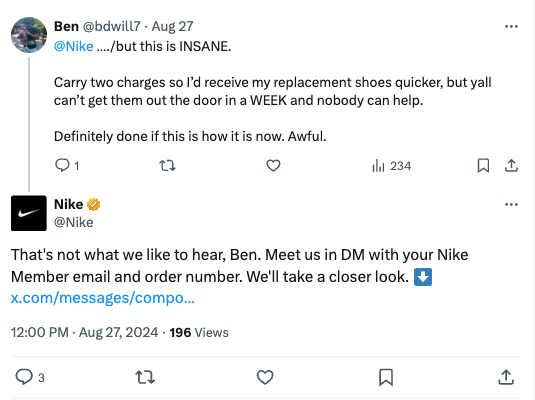
Source: Nike on X
Notice that these accounts have a consistent voice, tone, and style. That’s key to letting people know what to expect from your feed. That is, why should they follow you? What’s in it for them?
Consistency also helps keep your content on-brand even if you have multiple people on your social media team.
For more on this, read our guide on establishing a compelling brand voice on social media.
Ask your followers
Consumers can also offer social media inspiration.
What are your target customers talking about online? What can you learn about their wants and needs?
If you have existing social channels, you could also ask your followers what they want from you. Just make sure that you follow through and deliver what they ask for.
Step 7. Create a strategic social media content calendar
Marketing via social media is all about timing. Sharing great content is essential, of course, but it’s equally important to have a plan in place for when you’ll share content to get the maximum impact.
Your social media content calendar also needs to account for the time you spend interacting with the audience (although you should also allow for some spontaneous engagement).
Set your posting schedule
Your content calendar lists the dates and times at which you will publish types of content on each channel.
It’s the perfect place to plan all of your social media activities—from images, link sharing, and re-shares of user-generated content to blog posts and videos. It includes both your day-to-day posting and content for social media campaigns.
Your calendar also ensures your posts are spaced out appropriately and published at the best times to post.
Pro tip: You can plan your whole content calendar and get recommended best times to post on every network based on your past engagement rate, impressions, or link click data in Hootsuite.
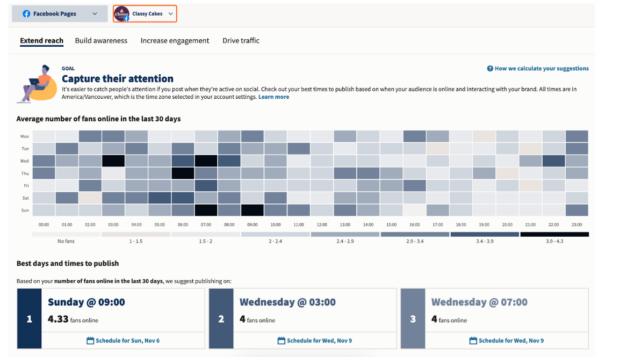
Hootsuite’s Best Time to Publish feature
Determine the right content mix
Make sure your content strategy and calendar reflect the mission statement you’ve assigned to each social profile. Strategic social media marketing means everything you post should support your business goals.
(We know, it’s tempting to jump on every meme, but there should always be a strategy behind your social media marketing efforts!)
You might decide that:
- 50% of content will drive traffic back to your website
- 25% of content will be curated from other sources
- 20% of content will support lead-generation goals (newsletter sign-ups, ebook downloads, etc.)
- 5% of content will be about your company culture
Placing these different post types in your content calendar will ensure you maintain the right mix.
If you’re starting from scratch and you’re not sure what types of content to post, try the 80-20 rule:
- 80% of your posts should inform, educate, or entertain your audience
- 20% can directly promote your brand.
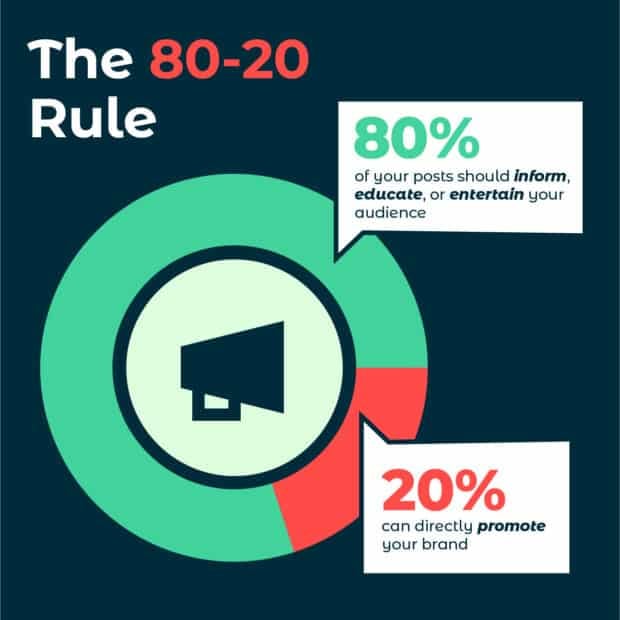
You could also try the social media content marketing rule of thirds:
- One-third of your content promotes your business, converts readers, and generates profit.
- One-third of your content shares ideas and stories from thought leaders in your industry or like-minded businesses.
- One-third of your content is personal interactions with your audience
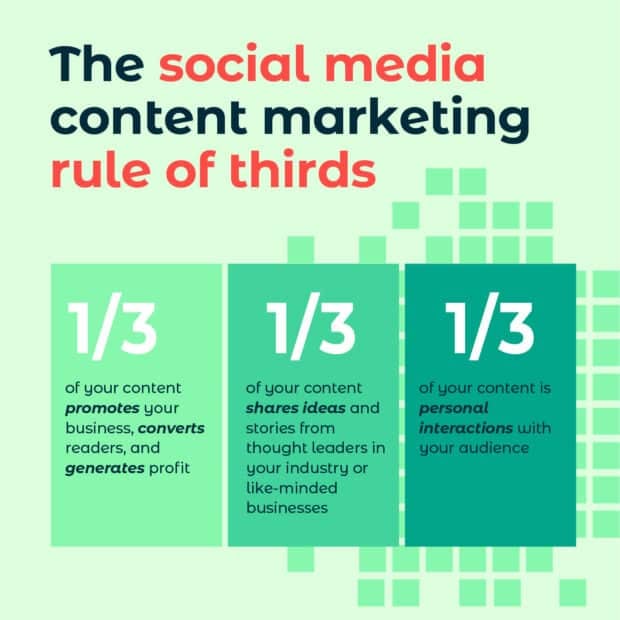
Whatever you decide on, be sure to document it in your strategy doc.
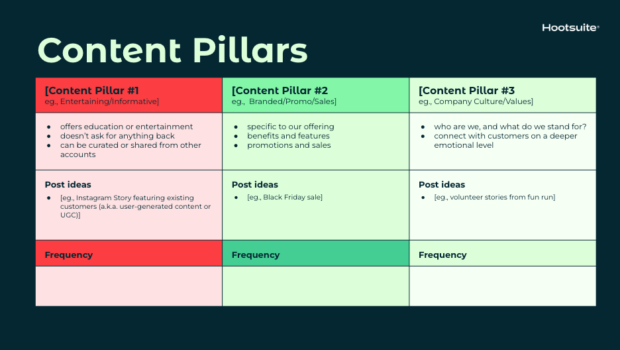
Don’t post too much or too little
If you’re starting a social media marketing strategy from scratch, you may not have figured out how often to post to each network for maximum engagement yet.
Post too frequently and you risk annoying your audience. But, if you post too little, you risk looking like you’re not worth following.
Start with these posting frequency recommendations:
- Instagram (feed): 3-7 times per week
- TikTok: 3-5 times per week
- Facebook: 1-2 times per day
- X (Twitter): 1-5 times per day
- LinkedIn: 1-5 times per day
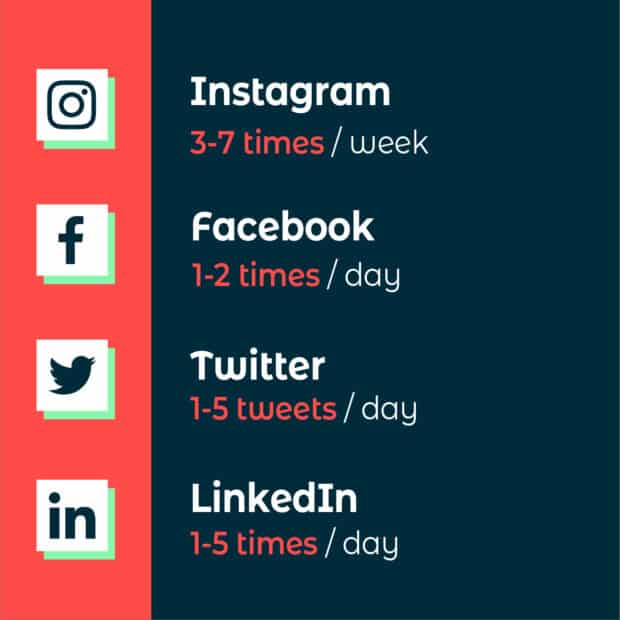
Pro tip: Once you have your social media content calendar planned out, use a scheduling tool to prepare messages in advance rather than updating constantly throughout the day.
We might be biased, but we think Hootsuite is the best social media management tool. You can schedule social media posts to every network and the intuitive calendar view gives you a full picture of all your social activity each week.

Step 8. Craft compelling and high-quality content
Remember those mission statements you created for each channel in Step 5? Well, it’s time to go a bit deeper, a.k.a. provide some examples of the type of content you’ll post to fulfill your mission on each network.
If you’re not sure what to post, here’s a long list of social media marketing ideas to get you started. Or (to make it even easier) you can use an AI tool like OwlyWriter to generate on-brand content in a flash.
The idea here is to:
- Keep your content aligned with the purpose of each network;
- Show other stakeholders (if applicable) what kind of content they can expect to see on each network.
This last point especially will help you avoid any tension when your colleagues want to know why you haven’t posted their case study/whitepaper/blog post to TikTok yet. It’s not in the strategy, Linda!
Ideally, you will generate content types that are both suited to the network and the purpose you’ve set out for that network. Your social media promotion strategy will not be the same for every network.
For example, you wouldn’t want to waste time posting brand awareness tweets if you’ve designated X/Twitter for primarily customer support. And you wouldn’t want to post super slick corporate video ads to TikTok, as users expect to see short, unpolished videos on that platform.
It might take some testing over time to figure out which type of content works best on which type of network, so prepare to update this section frequently.
We won’t lie: content creation isn’t as easy as everyone not on the social team seems to think. But if you’re struggling, Amanda suggests going back to basics.
The first question to ask is: is there cohesion between your content types? Is your content providing value? Do you have a good mix of entertaining, or educational content? What does it offer that makes a person stop and spend time?
Creating a few different content pillars or categories that encompass different aspects of storytelling for your brand, and what you can offer your audience is a good start.
This brings us to Step 9.
Step 9. Track performance and make adjustments
Your social media marketing strategy is a hugely important document for your business, and you can’t assume you’ll get it exactly right on the first try.
As you start to implement your plan and track your results, you may find that some strategies don’t work as well as you’d anticipated, while others are working even better than expected.
That’s why it’s important to document your progress along the way.
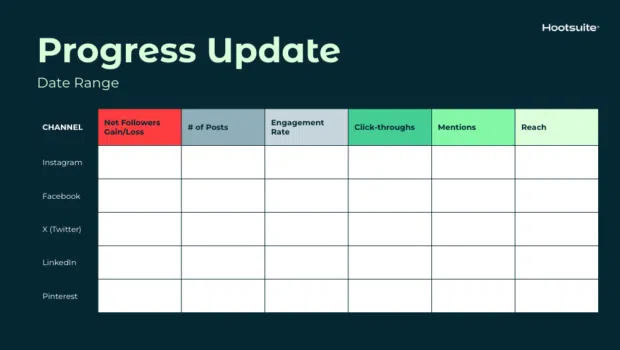
Look at performance metrics
In addition to the analytics within each social network (see Step 2), you can use UTM parameters to track social visitors as they move through your website, so you can see exactly which social posts drive the most traffic to your website.
Benchmark your results
You’ve got your numbers, but how do they stack up to the competition in your industry? Industry benchmarks are a great way to evaluate your performance against other businesses in your category.
If you’ve got Hootsuite Analytics, you can use our built-in social media benchmarking tool to compare the performance of your social accounts against the average of brands in your industry with just a couple of clicks.
You can set up custom timeframes, switch between networks — Instagram, Facebook, X (Twitter), LinkedIn, and TikTok — and look up benchmarks for metrics like followers, audience growth rate, engagement rate, clicks, shares, and much more.
You’ll also find resources to improve your performance right in the summary section:
Re-evaluate, test, and do it all again
Once this data starts coming in, use it to re-evaluate your social media marketing techniques regularly.
You can also use this information to test different posts, social marketing campaigns, and strategies against one another. Constant testing allows you to understand what works and what doesn’t, so you can refine your social media marketing strategy in real time.
Remember, good social media marketing isn’t static. Your strategy should change over time.
You should check the performance of all your channels at least once a week. Once you learn the basics of social media reporting, you can track your growth over time.
Pro tip: If you use Hootsuite, you can review the performance of all your posts on every network in one place. Once you get the hang of checking your analytics, you may even want to customize different reports to show specific metrics over a variety of different time periods.
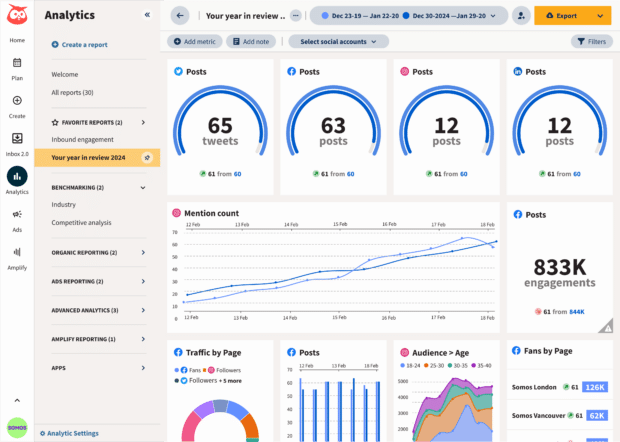
Surveys can also be a great way to find out how well your social media strategy is working. Ask your followers, email list, and website visitors whether you’re meeting their needs and expectations and what they’d like to see more of. Just make sure to deliver on what they tell you.
Finalizing your social media strategy
Spoiler alert: nothing is final.
Social media moves fast. New networks emerge, others go through demographic shifts.
Your business will go through periods of change as well.
All of this means that your social media marketing strategy should be a living document that you review and adjust as needed. Refer to it often to stay on track, but don’t be afraid to make changes so that it better reflects new goals, tools, or plans.
When you update your social strategy, make sure to watch our 5-step video on how to updating your social media strategy for 2024:
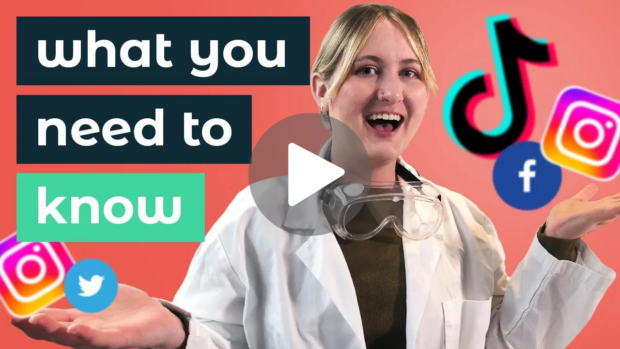
Social media strategy template
Ready to start documenting? Grab your free social marketing strategy template below!

Bonus: Get a free social media strategy template to quickly and easily plan your strategy, track results, and share with your boss, teammates, and clients.
What’s next? When you’re ready to put your plan into action, we’re here to help…
Save time managing your social media marketing strategy with Hootsuite. From a single dashboard, you can easily:
- Plan, create, and schedule posts to every network
- Track relevant keywords, topics, and accounts
- Stay on top of engagement with a universal inbox
- Get easy-to-understand performance reports and improve your strategy as needed
The post Social media marketing: Strategy template and tips for 2025 appeared first on Social Media Marketing & Management Dashboard.
Categories
- 60% of the time… (1)
- A/B Testing (2)
- Ad placements (3)
- adops (4)
- adops vs sales (5)
- AdParlor 101 (43)
- adx (1)
- AI (11)
- algorithm (1)
- Analysis (14)
- Apple (1)
- Audience (1)
- Augmented Reality (1)
- authenticity (1)
- Automation (1)
- Back to School (1)
- best practices (2)
- brand voice (1)
- branding (1)
- Build a Blog Community (12)
- Calculator (2)
- Case Studies (2)
- Case Study (3)
- celebrate women (1)
- certification (1)
- Collections (1)
- Community (1)
- Conference News (2)
- conferences (1)
- confluence (1)
- content (1)
- content creation (69)
- Content creators (9)
- content curation (1)
- content marketing (3)
- contests (1)
- Conversion Lift Test (1)
- Conversion testing (1)
- cost control (2)
- Creative (6)
- crisis (1)
- Curation (1)
- Custom Audience Targeting (4)
- Customer service (12)
- Digital Advertising (2)
- Digital Marketing (6)
- does DCM charge you by the report? (1)
- DPA (1)
- Dynamic Ad Creative (1)
- dynamic product ads (1)
- E-Commerce (1)
- eCommerce (2)
- Education (2)
- email marketing (3)
- Employee advocacy (3)
- employee advocacy program (1)
- employee advocates (1)
- engineers (1)
- event marketing (1)
- event marketing strategy (1)
- events (3)
- Experiments (40)
- F8 (2)
- Facebook (64)
- Facebook Ad Split Testing (1)
- facebook ads (18)
- Facebook Ads How To (1)
- Facebook Advertising (30)
- Facebook Audience Network (1)
- Facebook Creative Platform Partners (1)
- facebook marketing (1)
- Facebook Marketing Partners (2)
- Facebook Optimizations (1)
- Facebook Posts (1)
- facebook stories (1)
- Facebook Updates (2)
- Facebook Video Ads (1)
- Facebook Watch (1)
- fbf (11)
- feels good to be back (1)
- Financial services (3)
- first impression takeover (5)
- fito (5)
- Fluent (1)
- Free tool (4)
- Get Started With Wix Blog (1)
- Google (9)
- Google Ad Products (5)
- Google Analytics (1)
- Government (4)
- Guest Post (1)
- Guide (12)
- Guides (32)
- Halloween (1)
- Healthcare (2)
- holiday marketing (1)
- Holiday Season Advertising (7)
- Holiday Shopping Season (4)
- Holiday Video Ads (1)
- holidays (4)
- Hootsuite How-To (3)
- Hootsuite HQ (1)
- Hootsuite Life (1)
- how to (6)
- How to get Instagram followers (1)
- How to get more Instagram followers (1)
- i don't understand a single thing he is or has been saying (2)
- i’ll take ‘things that’ve never happened’ for $1000 (1)
- if you need any proof that we're all just making it up (2)
- Incrementality (1)
- influencer marketing (3)
- Infographic (1)
- Instagram (39)
- Instagram Ads (11)
- Instagram advertising (8)
- Instagram best practices (1)
- Instagram followers (1)
- Instagram Partner (1)
- Instagram Stories (2)
- Instagram tips (1)
- Instagram Video Ads (2)
- invite (1)
- Landing Page (1)
- Legal (1)
- link shorteners (1)
- LinkedIn (22)
- LinkedIn Ads (2)
- LinkedIn Advertising (2)
- LinkedIn Stats (1)
- LinkedIn Targeting (5)
- Linkedin Usage (1)
- List (1)
- listening (2)
- Lists (3)
- Livestreaming (1)
- look no further than the new yorker store (2)
- lunch (1)
- Mac (1)
- macOS (1)
- Marketing to Millennials (2)
- mental health (1)
- metaverse (2)
- mobile (2)
- Mobile App Marketing (3)
- Monetizing Pinterest (2)
- Monetizing Social Media (2)
- Monthly Updates (10)
- Mothers Day (1)
- movies for social media managers (1)
- new releases (11)
- News (80)
- News & Events (11)
- no one knows what they're doing (2)
- Non-profit (2)
- OnlineShopping (2)
- or ari paparo (2)
- owly shortener (1)
- Paid Media (2)
- People-Based Marketing (3)
- performance marketing (5)
- Pinterest (34)
- Pinterest Ads (11)
- Pinterest Advertising (8)
- Pinterest how to (1)
- Pinterest Tag helper (5)
- Pinterest Targeting (6)
- platform health (1)
- Platform Updates (8)
- Press Release (2)
- product catalog (1)
- Productivity (10)
- Programmatic (3)
- quick work (1)
- Real estate (5)
- Reddit (3)
- reels (1)
- Report (2)
- Reporting (1)
- Resources (27)
- ROI (1)
- rules (1)
- sales heart grew three times that day (1)
- Seamless shopping (1)
- share of voice (1)
- Shoppable ads (4)
- short-form video (2)
- shorts (2)
- Skills (25)
- SMB (1)
- SnapChat (28)
- SnapChat Ads (8)
- SnapChat Advertising (5)
- Social (145)
- social ads (1)
- Social Advertising (14)
- Social commerce (8)
- social customer service (1)
- Social Fresh Tips (2)
- Social listening (12)
- Social Media (5)
- Social Media Advertising (18)
- Social media analytics (36)
- social media automation (1)
- Social media benchmarks (2)
- Social media career (2)
- social media content calendar (1)
- Social media content creation (3)
- Social media engagement (15)
- social media for events (1)
- social media management (2)
- Social Media Marketing (49)
- social media monitoring (1)
- Social Media News (4)
- Social media scheduling (24)
- social media statistics (1)
- Social media stats (25)
- Social Media Strategy (165)
- social media tools (69)
- social media tracking in google analytics (1)
- Social media trends (14)
- social media tutorial (2)
- Social Toolkit Podcast (1)
- Social Video (32)
- stories (1)
- Strategy (1)
- Strategy (927)
- Teamwork (3)
- Template (21)
- terms (1)
- Testing (2)
- there are times ive found myself talking to ari and even though none of the words he is using are new to me (2)
- they've done studies (1)
- this is also true of anytime i have to talk to developers (2)
- tiktok (14)
- tool (1)
- tools (1)
- Topics & Trends (3)
- Trend (12)
- Twitter (15)
- Twitter Ads (5)
- Twitter Advertising (4)
- Uncategorised (9)
- Uncategorized (13)
- url shortener (1)
- url shorteners (1)
- vendor (2)
- video (14)
- Video Ads (7)
- Video Advertising (8)
- virtual conference (1)
- we're all just throwing mountains of shit at the wall and hoping the parts that stick don't smell too bad (2)
- web3 (2)
- whats the point in weekly reports? (1)
- where you can buy a baby onesie of a dog asking god for his testicles on it (2)
- why is this so fucking hard (1)
- yes i understand VAST and VPAID (2)
- yes that's the extent of the things i understand (2)
- you have a 10 day campaign (1)
- YouTube (13)
- YouTube Ads (4)
- YouTube Advertising (9)
- YouTube Video Advertising (5)


